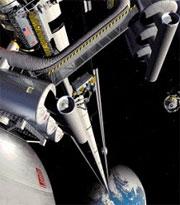 Fatally flawed? Nanotube fibres are expected to get weaker the longer they are.Credit: Pat Rawling / NASA
Fatally flawed? Nanotube fibres are expected to get weaker the longer they are.Credit: Pat Rawling / NASAIs it possible to make a cable for a space elevator out of carbon nanotubes? Not anytime soon, if ever, says Nicola Pugno of the Polytechnic of Turin, Italy. Pugno's calculations show that inevitable defects in the nanotubes mean that such a cable simply wouldn't be strong enough.
The idea of a space elevator was popularized in science fiction, where writers envisioned a 100,000-kilometre-long cable stretching straight up from the Earth's surface and fixed in a geosynchronous orbit. Payloads, or tourists, would simply ascend the cable into low-Earth orbit, eliminating the need for rocket launches.
When carbon nanotubes were discovered to have an incredibly high strength-to-weight ratio, researchers hoped they would take the idea out of fiction and bring it into reality.
But Pugno argues that atomic-scale defects in the nanotubes would reduce the strength of such a giant cable by at least 70%.
Space ribbon
Researchers think that the best shape for a space-elevator cable would be a ribbon, about a metre wide and as thin as paper. It would need to withstand at least 62 gigapascals (GPa) of tension. That's about as much as in the rope of a tug-of-war with more than 100,000 people on each side.
Laboratory tests have shown that individual nanotubes can withstand an average of about 100 GPa, an unusual strength that comes courtesy of their crystalline structure. But if a nanotube is missing just one carbon atom, this can reduce its strength by as much as 30%. And a bulk material made from such tubes is even weaker. Most fibres made from nanotubes have so far had a strength much lower than 1 GPa.
Recent measurements of high-quality nanotubes have found them to be missing one carbon atom out of every 1012 bonds; that's about one defect over 4 micrometres of nanotube length1. Defects of two or more missing atoms are much more rare, but Pugno points out that on the scale of the space elevator they become statistically probable.
Using a mathematical model that he has devised himself, and which has been tested by predicting the strength of materials such as nano-crystalline diamond, Pugno calculates that large defects will unavoidably bring a cable's strength below about 30 GPa. His paper has been posted to arXiv2, and will appear in the July edition of the Journal of Physics: Condensed Matter.
Pugno adds that even if flawless nanotubes could be made for the space elevator, damage from micrometeorites and even erosion by oxygen atoms would render them weak. So can a space elevator be made? "With the technology available today? Never," he says.
Never say never
This comes in sharp contrast to claims made by Bradley Edwards, whose space elevator feasibility study for NASA4 and a subsequent book have made him the most frequent spokesman for the project. Edwards, who is president and founder of the Dallas-based company Carbon Designs, shrugs off the controversy, and says that with adequate funding he could make cables at or above the 62-GPa benchmark in just three years. He suggests that the key step is carefully spinning long nanotubes together in a close-packed way, which encourages cooperative frictional forces that make the strengths of individual nanotubes less crucial.
Pugno counters that the larger defects critically weaken the cable, no matter what its construction. And lab efforts thus far don't seem to inspire much optimism. Ray Baughman, director of the NanoTech Institute in Dallas, published a paper in Science last year3 demonstrating metre-long cables spun in a similar way to Edwards' preferred design. But these too had a strength well below 1 GPa.
ADVERTISEMENT
Baughman says Pugno's results aren't surprising. It has been known for decades that crystalline materials are sensitive to defects, and that they show a clear drop in strength with increasing size. But he adds that a solution may one day be found. The space elevator, he says, "won't happen in my lifetime, but I don't like to say never."
Visit our spaceelevatorgoingdown.html">newsblog to read and post comments about this story.
-
References
- Fan , et al. Nature Mater., 4. 906 - 911 (2005). | Article |
- Pugno N., et al. arXiv preprint server, http://xxx.lanl.gov/abs/cond-mat/0601668. (2006).
- Edwards B. C., et al. Acta Astronaut., 47. 735 - 744 (2000).
- Zhang , et al. Science, 309. 1215 - 1219 (2005).
